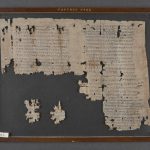| Artefact ID | 351 |
| TM ID | TM 32660 |
| Findspot (DEChriM ID) | - () | Class | Textual |
| Material | Papyrus |
| Writing medium | Sheet/roll |
| Text content | Documentary |
| Language | Greek |
| Archive/Dossier | Archive |
| Description | P.Lond. VI 1927: Letter from Dorotheos The letter is addressed to "the most valuable brother and beloved of God", from a certain Dorotheos. The receiver is not named but later referred to as someone who "renounced the boasting of the world" and there is no doubt that it was addressed to Papnouthios. The letter is very long but virtually empty of content, most part of it being occupied with compliments. The main object seems to concern whether the writer should "come up" to visit him. As the writer calls himself "Dorotheos the Oxyrhynchite", it is possible that he lived in Oxyrhynchus and would go up the Nile to see Papnouthios, which would mean that Papnouthios lived to the south of that city (or possibly in the desert). It has been suggested that Dorotheos was the bishop of Oxyrhynchus but according to M. Choat, his desire to "emulate your love of goodness in the same way of life" indicates he is more likely to have been a monk himself (see Choat 2017: 53). About the mention of the politeia, see also P.Neph. 14.
Recto: the letter is written in two columns (but lower half of col. 1 disappeared); the hand is a fair-sized sloping uncial, growing smaller towards the end; text written along the fibres. Use of nomina sacra according to literary standards; quotation of Ephesians 5:16 (l. 44-47). Verso: remains of at least one column of writing in a similar hand, across the fibres; some figures probably serving to mark the place of the string but no recognisable traces of address. |
| Selection criteria | Christian terms/formulas/concepts, Christian onomastics, Nomina sacra, Biblical quote or paraphrase |
| Date from | 325 |
| Date to | 375 |
| Dating criteria | No date occurs in the archive but palaeographically dated to the middle of the fourth century by comparison with the archive of Abinnaeus (c. 342-351). |
| Absolute/relative date | Relative date |
| Archaeological context | Purchased with a lot comprising Papyri 2486-2542 from Maurice Nahman (b. 1868, d. 1948) in September 1922 (British Library website). According to the dealer, the seven letters of the correspondence of Papnouthios were discovered together, but there is no information regarding the place of discovery (Bell 1924: 100). |
| Accession number | London, British Library, Pap 2495 |


 Json data
Json data





